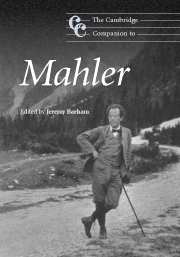Book contents
- Frontmatter
- Introduction: Marginalia on Mahler today
- PART ONE Cultural contexts
- PART TWO Mahler the creative musician
- 4 Juvenilia and early works: from the first song fragments to Das klagende Lied
- 5 Song and symphony (I). Lieder und Gesänge Volume 1, Lieder eines fahrenden Gesellen and the First Symphony: compositional patterns for the future
- 6 Song and song-symphony (I). Des Knaben Wunderhorn and the Second, Third and Fourth Symphonies: music of heaven and earth
- 7 Song and symphony (II). From Wunderhorn to Rückert and the middle-period symphonies: vocal and instrumental works for a new century
- 8 The ‘greatest’ and the ‘most personal’: the Eighth Symphony and Das Lied von der Erde
- 9 The last works
- PART THREE Mahler the re-creative musician
- PART FOUR Reception and performance
- Appendix: selected discography
- Notes
- Bibliography
- Index
5 - Song and symphony (I). Lieder und Gesänge Volume 1, Lieder eines fahrenden Gesellen and the First Symphony: compositional patterns for the future
from PART TWO - Mahler the creative musician
Published online by Cambridge University Press: 28 September 2011
- Frontmatter
- Introduction: Marginalia on Mahler today
- PART ONE Cultural contexts
- PART TWO Mahler the creative musician
- 4 Juvenilia and early works: from the first song fragments to Das klagende Lied
- 5 Song and symphony (I). Lieder und Gesänge Volume 1, Lieder eines fahrenden Gesellen and the First Symphony: compositional patterns for the future
- 6 Song and song-symphony (I). Des Knaben Wunderhorn and the Second, Third and Fourth Symphonies: music of heaven and earth
- 7 Song and symphony (II). From Wunderhorn to Rückert and the middle-period symphonies: vocal and instrumental works for a new century
- 8 The ‘greatest’ and the ‘most personal’: the Eighth Symphony and Das Lied von der Erde
- 9 The last works
- PART THREE Mahler the re-creative musician
- PART FOUR Reception and performance
- Appendix: selected discography
- Notes
- Bibliography
- Index
Summary
Mahler was a prolific composer neither in quantity nor in his choice of genres, and the diversity evident in his early music was not to recur. The ‘early’ compositions that were published in his lifetime include four markedly different works or groups of pieces. His hybrid cantata-oratorio Das klagende Lied is discussed in Chapter 4. The five pieces in Volume 1 of Lieder und Gesänge (aus der Jugendzeit, as the title's later, unauthorized extension has it) comprise a group of miscellaneous solo songs with piano accompaniment. Lieder eines fahrenden Gesellen is a set of four, apparently similar songs in that they, too, were initially written for voice and piano. But these pieces constitute a true cycle, and were to be turned into the composer's first orchestral songs. This, the ‘first period’ of Mahler's creativity came to a close with the First Symphony, again a cyclic work that was to be recast. He took some ten years to write these works, beginning with the text of Das klagende Lied in 1878, and ending with the ‘Symphonic Poem in two parts’, the original, five-movement form of the First Symphony, in the spring of 1888. Those years saw him advance from an adolescent, unemployed graduate of the Vienna Conservatoire to the threshold of the international musical stage as director-designate of the Royal Hungarian Opera. Indeed, that lofty position was to play an important part in securing Mahler's first appearance as a composer of consequence with the première of the ‘Symphonic Poem’ in 1889.
- Type
- Chapter
- Information
- The Cambridge Companion to Mahler , pp. 72 - 88Publisher: Cambridge University PressPrint publication year: 2007
- 1
- Cited by



